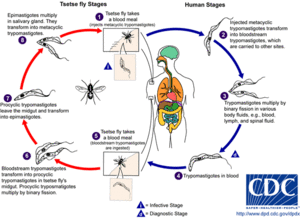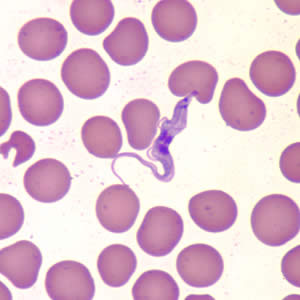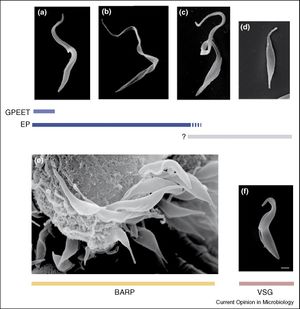Trypanosome Life Cycle: Difference between revisions
Rodriguezr (talk | contribs) |
Rodriguezr (talk | contribs) |
||
| Line 20: | Line 20: | ||
==Introduction== | ==Introduction== | ||
[[Image:Tbrucei_thin_giemsa_divide.jpg|200 × 200 px|right|thumb|Microscopic image of <i>Trypanosoma brucei</i> during replication. Slide taken from a thick blood smear, stained with Giemsa [http://www.dpd.cdc.gov/dpdx/HTML/ImageLibrary/TrypanosomiasisAfrican_il.htm]]] | [[Image:Tbrucei_thin_giemsa_divide.jpg|200 × 200 px|right|thumb|Microscopic image of <i>Trypanosoma brucei</i> during replication. Slide taken from a thick blood smear, stained with Giemsa [http://www.dpd.cdc.gov/dpdx/HTML/ImageLibrary/TrypanosomiasisAfrican_il.htm]]] | ||
<br> | <br> | ||
Revision as of 15:02, 17 April 2009

Introduction

Trypanosoma brucei and its related subspecies are parasitic hemoflagellate protists that are implicated in a severe meningoencephalitic disease, African trypanosomiasis, more commonly known as “sleeping sickness.” Sleeping sickness itself is identified as a neurological disorder preceded by an acute lymphatic infection. The disease garners its name from the effect it has of creating severe fatigue in a patient followed by bouts of mania and eventually causing coma and death. It is known to have affected up to 36 sub-Saharan countries with an estimated 300,000 new infections each year. A more complete understanding of the life cycle of this particularly fatal disease has been incited by organizations such as the WHO in order to create novel treatments for the disease before it develops into a much more deadly issue.
Protists of the genus trypanosoma are a fairly typical eukaryotic flagellates with fully intact and functional organelles including mitochondria and nuclei (which is atypical of most obligate parasites). T. brucei mitochondria contain kinetoplasts, condensed regions of mitochondrial DNA maintained within the mitochondria. The kinetoplast is closely associated with the flagellum of the trypanosome and is believed to be an essential part of the regulation of flagellar motility as the parasite enters different stages of its life cycles. Perhaps the most fascinating and unique characteristic of T. brucei is the ability to alter the composition of a dense glycoprotein coat in order to evade the specific immune response mechanisms of the host body.
Ecologically, T. brucei is an obligate parasite and requires the presence of a host cell to function. However, it is not readily transmittable between mammalian hosts and facilitates the use of an insect vector: the flies of the genus Glossina, otherwise known as the Tsetse flies. These flies are endemic to 36 sub-Saharan countries and are found, unsurprisingly, within the range of trypanosomiasis infections. Tsetse flies themselves are not fatally infected by the parasites as their hemolymph is not capable of providing the amount of sustenance necessary for trypanosomal reproduction, but they are mildly affected by the trypanosomes presence.
Within both the human and fly hosts, T. brucei undergoes a series of wildly pleomorphic events that are necessary for the successful transmission of the parasite. For example, within the fly the parasite expresses a coat that is made of several different procyclin molecules. Before transmission to the human host, the trypanosome gathers the previously mentioned variable surface glycoprotein (VSG) coat. In fact, for almost all trypanosomes, infectivity from the insect vector to the mammal host correlates with the expression of a dense VSG coat.
Once within the host, T. brucei undergoes several morphological and enzymatic changes to facilitate inter-host transfer of the parasite to various organ systems including the lymphatic system and the central nervous system. Each of these transfers are facilitated in different ways and the timing and the severity of the infection vary depending on which subspecies of T. brucei are causing the infection. Subspecies rhodesiense is a form of the disease categorized by an acute onset of neurological complications and requires treatment within days of infection before the disease becomes fatal. Subspecies gambiense is a much more chronic form of the disease with cyclical infective patterns marked by a rapid change in the VSG coat of the parasite. While there is not a complete understanding of the methods by which each of these subspecies function, researchers have been collecting a vast amount of information regarding the developmental cycles of T. brucei in order to effectively combat the disease.
Antigenic Variation

Development within Insect Vector
Pathogenicity within Host
Conclusion
References
1. Krafsur, K. "Tsetse flies: Genetics, evolution, and role as vectors" Infection, Genetics and Evolution 2009. Volume 9 p.124-141
2. Taylor, J. Rudenko, G. "Switching trypanosome coats: what's in the wardrobe?" Trends in Genetics. 2006. Volume 22 No. 11
p.614-621
3. Donelson, J. "Antigenic variation and the African trypanosome genome" Acta Tropica. 2003. Volume 85 p.391-404
4. Nikolskala, O. Lima, A. Kim, Y. Lonsdale-Eccles, J. Fukuma, T. Scharfstein, J. Grab, D. "Blood-brain barrier traversal by
African trypanosomes requires calcium signaling induced by parasite cysteine protease" The Journal of Clinical Investigation.
2006. Volume 116 No. 10 p.2739-2747
5.
Edited by student of Joan Slonczewski for BIOL 238 Microbiology, 2009, Kenyon College.
